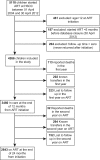Predictors of loss to follow-up among children in the first and second years of antiretroviral treatment in Johannesburg, South Africa
- PMID: 23364098
- PMCID: PMC3556704
- DOI: 10.3402/gha.v6i0.19248
Predictors of loss to follow-up among children in the first and second years of antiretroviral treatment in Johannesburg, South Africa
Abstract
Background: Ninety percent of the world's 2.1 million HIV-infected children live in sub-Saharan Africa, and 2.5% of South African children live with HIV. As HIV care and treatment programmes are scaled-up, a rise in loss to follow-up (LTFU) has been observed.
Objective: The aim of the study was to determine the rate of LTFU in children receiving antiretroviral treatment (ART) and to identify baseline characteristics associated with LTFU in the first year of treatment. We also explored the effect of patient characteristics at 12 months treatment on LTFU in the second year.
Methods: The study is an analysis of prospectively collected routine data of HIV-infected children at the Harriet Shezi Children's Clinic (HSCC) in Soweto, Johannesburg. Cox proportional hazards models were fitted to investigate associations between baseline characteristics and 12-month characteristics with LTFU in the first and second year on ART, respectively.
Results: The cumulative probability of LTFU at 12 months was 7.3% (95% CI 7.1-8.8). In the first 12 months on ART, independent predictors of LTFU were age <1 year at initiation, recent year of ART start, mother as a primary caregiver, and being underweight (WAZ ≤ -2). Among children still on treatment at 1 year from ART initiation, characteristics that predicted LTFU within the second year were recent year of ART start, mother as a primary caregiver, being underweight (WAZ ≤ -2), and low CD4 cell percentage.
Conclusions: There are similarities between the known predictors of death and the predictors of LTFU in the first and second years of ART. Knowing the vital status of children is important to determine LTFU. Although HIV-positive children cared for by their mothers appear to be at greater risk of becoming LTFU, further research is needed to explore the challenges faced by mothers and other caregivers and their impact on long-term HIV care. There is also a need to investigate the effects of differential access to ART between mothers and children and its impact on ART outcomes in children.
Keywords: HIV; South Africa; antiretroviral treatment; children; loss to follow-up.
Figures
Similar articles
-
High loss to follow-up of children on antiretroviral treatment in a primary care HIV clinic in Johannesburg, South Africa.Medicine (Baltimore). 2018 Jul;97(29):e10901. doi: 10.1097/MD.0000000000010901. Medicine (Baltimore). 2018. PMID: 30024494 Free PMC article.
-
Determinants of loss to follow-up among HIV positive patients receiving antiretroviral therapy in a test and treat setting: A retrospective cohort study in Masaka, Uganda.PLoS One. 2020 Apr 7;15(4):e0217606. doi: 10.1371/journal.pone.0217606. eCollection 2020. PLoS One. 2020. PMID: 32255796 Free PMC article.
-
Incidence of loss to follow-up and its predictors among HIV-infected under-five children after initiation of antiretroviral therapy in West Amhara Comprehensive Specialized Referral Hospitals, Northwest Ethiopia: a multicenter retrospective follow-up study.BMC Pediatr. 2024 Sep 28;24(1):615. doi: 10.1186/s12887-024-05086-2. BMC Pediatr. 2024. PMID: 39342164 Free PMC article.
-
The proportion of loss to follow-up from antiretroviral therapy (ART) and its association with age among adolescents living with HIV in sub-Saharan Africa: A systematic review and meta-analysis.PLoS One. 2022 Aug 11;17(8):e0272906. doi: 10.1371/journal.pone.0272906. eCollection 2022. PLoS One. 2022. PMID: 35951621 Free PMC article.
-
Retention in care of HIV-infected children from HIV test to start of antiretroviral therapy: systematic review.PLoS One. 2013;8(2):e56446. doi: 10.1371/journal.pone.0056446. Epub 2013 Feb 20. PLoS One. 2013. PMID: 23437135 Free PMC article.
Cited by
-
Exploring factors influencing patient mortality and loss to follow-up in two paediatric hospital wards in Zamfara, North-West Nigeria, 2016-2018.PLoS One. 2021 Dec 31;16(12):e0262073. doi: 10.1371/journal.pone.0262073. eCollection 2021. PLoS One. 2021. PMID: 34972177 Free PMC article.
-
Stunting and growth velocity of adolescents with perinatally acquired HIV: differential evolution for males and females. A multiregional analysis from the IeDEA global paediatric collaboration.J Int AIDS Soc. 2019 Nov;22(11):e25412. doi: 10.1002/jia2.25412. J Int AIDS Soc. 2019. PMID: 31702088 Free PMC article.
-
Poor clinical outcomes for HIV infected children on antiretroviral therapy in rural Mozambique: need for program quality improvement and community engagement.PLoS One. 2014 Oct 20;9(10):e110116. doi: 10.1371/journal.pone.0110116. eCollection 2014. PLoS One. 2014. PMID: 25330113 Free PMC article.
-
Outcomes of HIV Positive Children and Adolescents Initiated on Antiretroviral Treatment in Nigeria (2007-2016).J Int Assoc Provid AIDS Care. 2022 Jan-Dec;21:23259582221117009. doi: 10.1177/23259582221117009. J Int Assoc Provid AIDS Care. 2022. PMID: 35929105 Free PMC article.
-
Implementation of Antiretroviral Therapy for Life in Pregnant/Breastfeeding HIV+ Women (Option B+) Alongside Rollout and Changing Guidelines for ART Initiation in Rural Zimbabwe: The Lablite Project Experience.J Acquir Immune Defic Syndr. 2017 Apr 15;74(5):508-516. doi: 10.1097/QAI.0000000000001267. J Acquir Immune Defic Syndr. 2017. PMID: 27984555 Free PMC article.
References
-
- De Baets AJ, Ramet J, Msellati P, Lepage P. The unique features of pediatric HIV-1 in sub-Saharan Africa. Curr HIV Res. 2008;6:351–62. - PubMed
-
- Shisana O, Rehle T, Simbayi LC, Zuma K, Jooste S, Pillay-van Wyk V, et al. Capetown: HRSC Press; 2009. South African national HIV prevalence, incidence, behaviour and communication survey 2008: a turning tide among teenagers? Available from: http://www.hsrc.ac.za/Document-3239.phtml [cited 15 June 2012]
-
- UNAIDS. South Africa: UNAIDS; HIV and AIDS estimates. Available from: http://www.unaids.org/en/regionscountries/countries/southafrica/ [cited 10 May 2012].
-
- Klausner JD, Serenata C, O'Bra H, Mattson CL, Brown JW, Wilson M, et al. Scale-up and continuation of antiretroviral therapy in South African treatment programs, 2005–2009. J Acquir Immune Defic Syndr. 2011;56:292–5. - PubMed
-
- Fatti G, Bock P, Eley B, Mothibi E, Grimwood A. Temporal trends in baseline characteristics and treatment outcomes of children starting antiretroviral treatment: an analysis in four provinces in South Africa, 2004–2009. J Acquir Immune Defic Syndr. 2011;58:60–7. - PubMed
Publication types
MeSH terms
Substances
LinkOut - more resources
Full Text Sources
Other Literature Sources
Medical
Research Materials


